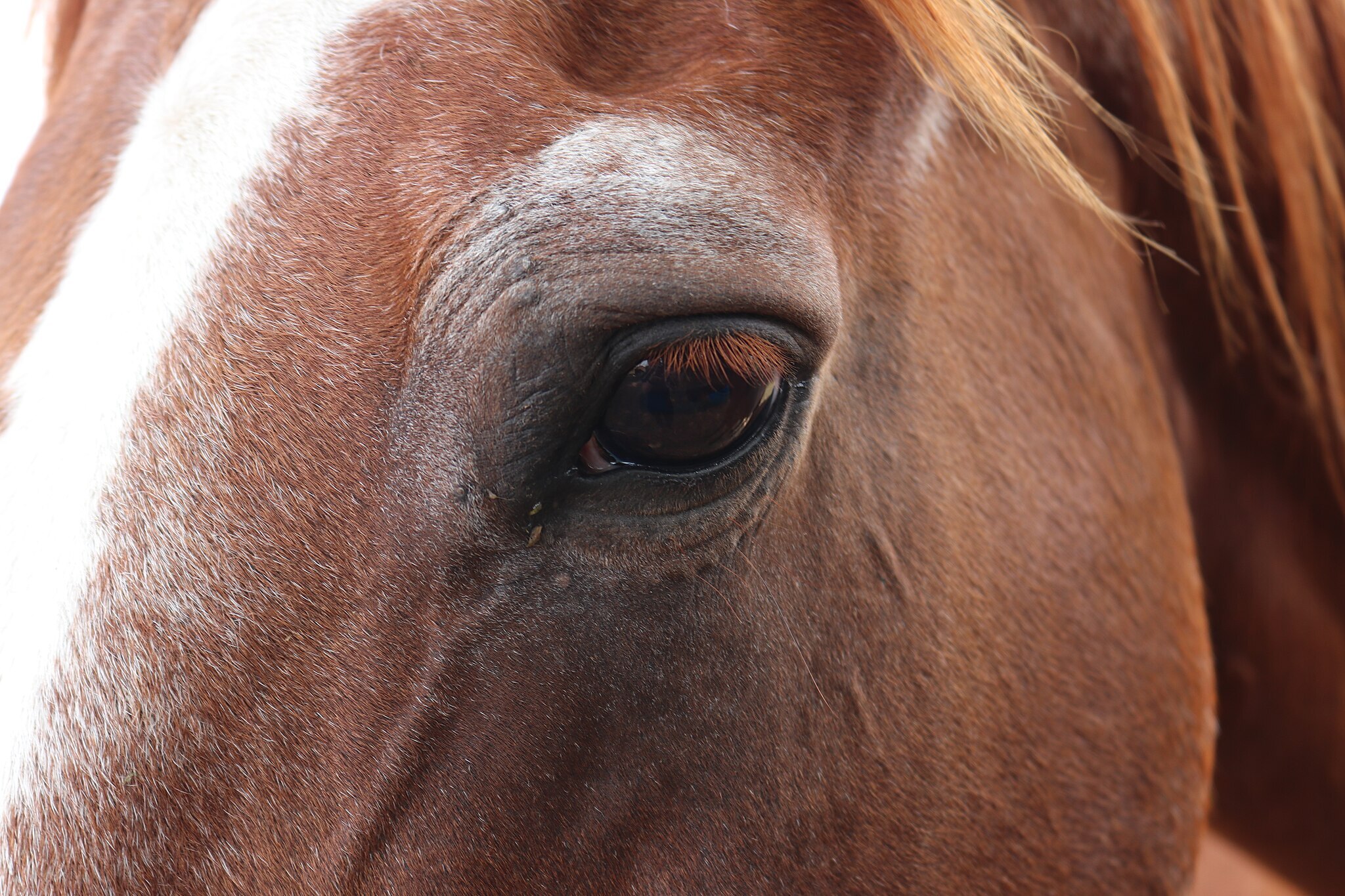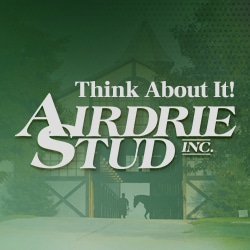
There is no one magic year a horse becomes a senior. Rather, you must take into consideration their physiological condition, says Dr. Jyme Nichols.
Photo credit: Anja, CC BY-SA 4.0, via Wikimedia Commons
Every horse has unique health and nutritional considerations — perhaps none more so than the senior off-track Thoroughbred.
Most equine experts consider horses seniors within the 15- to 20-year-old range; however, “age is really just a number,” says Jyme Nichols, PhD, director of nutrition with Bluebonnet Feeds, in Ardmore, Oklahoma. “There is no one magic year that a horse becomes a senior. Rather, you must take into consideration their physiological condition.”
To best support our senior OTTBs, let’s review their nutritional needs along with common career or workload considerations we need to make as they age.
Senior OTTB Nutrition
As horses age and undergo physiological changes, their nutritional needs shift, too.
“Younger OTTBs typically require higher energy levels to support growth and vigorous activity. In contrast, senior horses need diets higher in fiber and lower in nonstructural carbohydrates (NSCs) to aid digestion and prevent metabolic disorders,” says Nichols. “If dietary changes are not implemented, a senior OTTB can quickly drop weight, and you may find it difficult to put any extra weight back on.”
To safely add calories to help maintain horses’ weight, Nichols recommends owners:
- Feed alfalfa hay and good quality grass hay.
- Avoid feeding stemmy and mature hay, with tougher fiber to ferment.
- Supplement using fats, oils and highly fermentable fibers.
- Consider incorporating flax, rice bran and plant or marine-derived oils, along with beet pulp.
Due to dental disease or tooth loss, senior horses can have a more difficult time thoroughly chewing fiber. This can reduce their ability to absorb vitamins and minerals or ferment fiber sources.
“Therefore, easily digestible fiber sources, like beet pulp and higher quality hay with higher nutritional content are important considerations for seniors,” says Nichols. “Protein requirements also resurface as a priority for seniors as it becomes more challenging to absorb and utilize amino acids, which makes it more difficult to maintain muscle mass.”
For seniors still competing, Nichols likes to keep them on extra amino acids for muscle and topline support, omega-3 fatty acids to combat inflammation and oral plasma to support the immune system and digestive function.
Senior OTTB Health
Dental care for older equids
Senior horses need one to two dental floats per year.
“Starting at 15 and beyond 20-plus years of age, horse’s teeth stop growing, so you can get in situations when teeth are worn out, and you can get abnormalities of mastication,” says Laurie Beard, DVM, MS, Dipl. ACVIM, clinical professor of equine medicine and surgery at Kansas State University, in Manhattan. “It is important throughout a horse’s lifespan, especially in their middle age, to stay current with dentistry to preserve their teeth.”
Horses losing several molars cause the greatest concern.
“In these situations we have to start feeding them differently because they can no longer masticate hay and get nutritional value,” says Beard. “Complete senior feed becomes important.” (Complete feeds contain everything your horse needs in his diet, including the forage.)
Colic risk for senior horses
“Senior horses are more prone to colic when their teeth have not been well maintained, if they do not stay hydrated or if they eat hay that is stemmy,” says Nichols.
“Colic in a geriatric horse can also be more of a concern due to strangulating lipoma,” says Beard, referring to a benign fatty tumor of connective tissue that wraps around the small intestine and impacts blood supply. “Impaction colic becomes more common as well. Seniors also experience more postoperative complications, which can result in a significant increase in cost.”
Watch for common colic signs such as looking or kicking at the abdomen, pacing and pawing, sweating, lying down or rolling/thrashing and a heart rate over 45 beats per minute.
Equine Cushing’s disease
Pituitary pars intermedia dysfunction (PPID, formerly known as equine Cushing’s disease) is a progressive neurodegenerative disorder commonly found in senior horses that causes the pituitary gland to produce excess hormones that regulate body functions. Mild to severe clinical signs of PPID can include decreased athletic performance, reduced muscle mass, delayed/absent shedding of winter coat, change in energy levels, excess fat tissue on tail head or neck, laminitis and abnormal sweating.
If your senior OTTB displays any of these signs, speak with your veterinarian about PPID testing options and prescription medication to help manage the condition.
Arthritis in senior horses
“With the high athletic use of Thoroughbred racehorses, (individuals with) previous injures such as chip fractures and others can have a higher risk for developing arthritis later in life,” says Beard. “Lameness is a big issue in older horses.”
In addition to joint trauma, factors such as conformation, improper trimming and shoeing and age can also contribute to osteoarthritis (OA) in horses. Common signs of arthritis include lameness; swollen, stiff or painful joints; warmth in the joints and hesitance to move.
Work with your veterinarian to determine the best method to manage a horse’s OA. Your veterinarian might recommend prescription medication, trusted joint supplements or even joint injections.
“Arthritis is something you have to be on top of, address rapidly and maintain routinely,” says Steven Allday, DVM, an equine lameness and sports medicine specialist based in Simpsonville, Kentucky. “You may even have to go to anti-inflammatories to maintain a horse’s athletic career.”
Ulcers in senior horses
Gastric ulcers can contribute to weight maintenance challenges in horses. The equine stomach continuously secretes acid, which can cause ulceration of the stomach lining.
A high percentage of racehorses at the track experience gastric ulcers, says Beard, “and after Thoroughbreds retire, they could be more prone to ulcers. If a horse goes off feed and is not eating well, gastric ulcers could be a concern.”
Common signs of ulcers include weight loss, change in eating or drinking habits and overall attitude, colic, poor performance and a dull hair coat.
Know Your Horse’s Baseline
Getting to know what’s normal for your horse—especially as he ages—lays the groundwork for managing his health throughout his life.
“You yourself are the first point of contact for your horse, and you have to know their baseline,” explains Allday. “Nobody knows your horse as well as you do, with the time that you have spent with them as they have aged or progressed in their career. You know them better than anybody and are your horse’s first line of defense when change occurs.”
Allday recommends checking your horse over with every ride. For 40 years, seven days a week, he has run his hands down his horses’ legs, checking for any fluid buildup and for pulses (indicating injury or pain). He also looks over their topline development for any changes.
“All of those are indicative of the conformation of his body condition and body score and how he is carrying himself,” he says. “It’s a good habit to get into to evaluate your horse. If you see something different, you have a horse that is bilaterally asymmetrical, and you can check the opposite limb.”
Allday stresses the importance of preventive vs. restorative medicine, especially for senior OTTBs.
“For older horses, preventive maintenance is paramount,” he says. “If you let something go on for so long, the powers of healing in older horses have really diminished. You have to prioritize preventive, or you won’t have an old horse.”
Senior OTTB Career Considerations
“A horse who can actively compete into their 20s is doing so because somebody took great care of them throughout their lifetime and invested in a quality nutrition program, dental care, farrier and veterinary team,” says Nichols.
Off-track Thoroughbreds can remain competitive in their careers well into their golden years and remaining active — or at the minimum, being on pasture turnout to keep moving — is the best thing for a healthy senior.
“Constant movement and turning horses out is better than keeping them in a stall,” says Beard. “Geriatric horses tend to be safer horses and are wonderful horses for people who are learning how to ride.”
Work with your veterinarian to determine your senior OTTB’s suitability for his work. Often in the hunter/jumpers a horse jumping 3 feet gets into their 20s and can move down to still be a competitive, and content, 2-foot horse, says Beard. Signs a horse might need to move down a level can include tripping, lameness and refusing jumps.
“If they are in good body condition, they are maintaining muscle mass, they are sound and they are enjoying their job, there is no reason for retirement at a certain age,” says Nichols. “But as soon as they become uncomfortable in the show ring or they are not able to absorb nutrition and maintain weight, it’s time to consider changes in order to reduce stress on their body and lower nutrient demands.”
Take-Home Message
Senior OTTBs, whether competing in the show ring or enjoying pasture turnout, bring immense joy into our lives. Keep these thoughts in mind to help them best live out their golden years.
“Horses are like having children that never grow up,” says Allday. “They have to be fed, looked at and cared for. That is the reality of having horses. Attention to detail never goes out the window, whether young or old. Be cognizant of these things that can keep your partnership thriving and improve their quality of life.”

